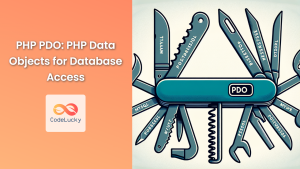In today's digital landscape, blockchain technology has emerged as a revolutionary force, reshaping industries and redefining how we approach data security, transparency, and decentralization. As a PHP developer, understanding how to interact with blockchain technologies can open up a world of exciting possibilities for your applications. In this comprehensive guide, we'll explore how PHP can be used to interact with blockchain technologies, providing you with the knowledge and tools to integrate these powerful concepts into your projects.
Understanding Blockchain Basics
Before we dive into the PHP implementation, let's briefly recap what blockchain is and why it's important.
🔗 Blockchain is a distributed ledger technology that allows data to be stored globally on thousands of servers. It's known for its:
- Immutability: Once data is recorded, it cannot be altered.
- Transparency: All transactions are visible to network participants.
- Decentralization: No single entity controls the network.
- Security: Cryptographic techniques ensure data integrity.
PHP and Blockchain: Getting Started
While PHP isn't typically the first language that comes to mind when thinking about blockchain development, it can be a powerful tool for interacting with blockchain networks. Let's explore some ways to get started.
1. Using Blockchain APIs
One of the easiest ways to interact with blockchain networks using PHP is through APIs provided by blockchain platforms or third-party services.
Let's look at an example using the Ethereum blockchain:
<?php
function getEthereumBalance($address) {
$apiKey = 'YOUR_API_KEY';
$url = "https://api.etherscan.io/api?module=account&action=balance&address={$address}&tag=latest&apikey={$apiKey}";
$response = file_get_contents($url);
$data = json_decode($response, true);
if ($data['status'] == '1') {
$balance = $data['result'] / 1000000000000000000; // Convert Wei to Ether
return $balance;
} else {
return "Error: " . $data['message'];
}
}
$address = '0x742d35Cc6634C0532925a3b844Bc454e4438f44e';
$balance = getEthereumBalance($address);
echo "Balance of {$address}: {$balance} ETH";
In this example, we're using the Etherscan API to fetch the balance of an Ethereum address. Here's what's happening:
- We define a function
getEthereumBalancethat takes an Ethereum address as input. - We construct a URL for the Etherscan API, including our API key and the address we want to check.
- We use
file_get_contentsto make a GET request to the API. - We parse the JSON response and extract the balance.
- We convert the balance from Wei (the smallest unit of Ether) to Ether.
- Finally, we print the balance.
🔑 Remember to replace 'YOUR_API_KEY' with your actual Etherscan API key.
2. Implementing Blockchain Concepts
While interacting with existing blockchains is useful, understanding the underlying concepts by implementing them in PHP can be incredibly educational. Let's create a simple blockchain structure:
<?php
class Block {
public $index;
public $timestamp;
public $data;
public $previousHash;
public $hash;
public function __construct($index, $timestamp, $data, $previousHash = '') {
$this->index = $index;
$this->timestamp = $timestamp;
$this->data = $data;
$this->previousHash = $previousHash;
$this->hash = $this->calculateHash();
}
public function calculateHash() {
return hash('sha256', $this->index . $this->timestamp . json_encode($this->data) . $this->previousHash);
}
}
class Blockchain {
private $chain;
public function __construct() {
$this->chain = [$this->createGenesisBlock()];
}
private function createGenesisBlock() {
return new Block(0, date('Y-m-d H:i:s'), "Genesis Block", "0");
}
public function getLatestBlock() {
return $this->chain[count($this->chain) - 1];
}
public function addBlock($newBlock) {
$newBlock->previousHash = $this->getLatestBlock()->hash;
$newBlock->hash = $newBlock->calculateHash();
$this->chain[] = $newBlock;
}
public function isChainValid() {
for ($i = 1; $i < count($this->chain); $i++) {
$currentBlock = $this->chain[$i];
$previousBlock = $this->chain[$i - 1];
if ($currentBlock->hash !== $currentBlock->calculateHash()) {
return false;
}
if ($currentBlock->previousHash !== $previousBlock->hash) {
return false;
}
}
return true;
}
public function displayChain() {
foreach ($this->chain as $block) {
echo "Block #{$block->index}\n";
echo "Timestamp: {$block->timestamp}\n";
echo "Data: " . json_encode($block->data) . "\n";
echo "Previous Hash: {$block->previousHash}\n";
echo "Hash: {$block->hash}\n\n";
}
}
}
// Usage
$codeluckyCoin = new Blockchain();
$codeluckyCoin->addBlock(new Block(1, date('Y-m-d H:i:s'), ["amount" => 4]));
$codeluckyCoin->addBlock(new Block(2, date('Y-m-d H:i:s'), ["amount" => 10]));
$codeluckyCoin->displayChain();
echo "Is blockchain valid? " . ($codeluckyCoin->isChainValid() ? "Yes" : "No") . "\n";
This example demonstrates a basic blockchain implementation in PHP. Let's break it down:
-
We define a
Blockclass that represents a single block in the blockchain. Each block has:- An index
- A timestamp
- Data (which could be transaction information)
- The hash of the previous block
- Its own hash
-
The
Blockchainclass manages the chain of blocks. It includes methods to:- Create the genesis block (the first block in the chain)
- Add new blocks
- Validate the integrity of the chain
- Display the entire blockchain
-
We use SHA-256 hashing to generate unique hashes for each block.
-
The
isChainValidmethod checks if the blockchain is valid by verifying:- Each block's hash is correct
- Each block's
previousHashmatches the hash of the actual previous block
-
In the usage example, we create a new blockchain, add some blocks, display the chain, and check its validity.
This implementation showcases key blockchain concepts like immutability (through hashing) and the chain structure.
Advanced Topics: Smart Contracts and PHP
While PHP can't directly execute smart contracts (which typically run on platforms like Ethereum), it can interact with them through APIs or libraries.
Here's an example of how you might interact with an Ethereum smart contract using PHP and the Web3.php library:
<?php
require_once 'vendor/autoload.php';
use Web3\Web3;
use Web3\Contract;
$web3 = new Web3('https://mainnet.infura.io/v3/YOUR_INFURA_PROJECT_ID');
$abi = json_decode('[{"constant":true,"inputs":[],"name":"name","outputs":[{"name":"","type":"string"}],"type":"function"},{"constant":true,"inputs":[],"name":"symbol","outputs":[{"name":"","type":"string"}],"type":"function"}]', true);
$contractAddress = '0x6B175474E89094C44Da98b954EedeAC495271d0F'; // DAI token contract
$contract = new Contract($web3->provider, $abi);
$contract->at($contractAddress)->call('name', function ($err, $name) {
if ($err !== null) {
echo 'Error: ' . $err->getMessage();
} else {
echo 'Contract name: ' . $name[0];
}
});
$contract->at($contractAddress)->call('symbol', function ($err, $symbol) {
if ($err !== null) {
echo 'Error: ' . $err->getMessage();
} else {
echo 'Contract symbol: ' . $symbol[0];
}
});
In this example:
- We're using the Web3.php library to interact with the Ethereum network.
- We define the ABI (Application Binary Interface) of the smart contract we want to interact with.
- We specify the contract address (in this case, the DAI token contract on the Ethereum mainnet).
- We create a new Contract object and use it to call the
nameandsymbolfunctions of the smart contract.
🔧 Note: You'll need to install the Web3.php library using Composer and replace 'YOUR_INFURA_PROJECT_ID' with your actual Infura project ID.
Security Considerations
When working with blockchain technologies, especially when handling cryptocurrencies or sensitive data, security is paramount. Here are some key considerations:
-
Private Key Management: Never store private keys in your PHP code or in version control. Use secure key management solutions.
-
Input Validation: Always validate and sanitize user inputs to prevent injection attacks.
-
Use HTTPS: Ensure all API calls are made over HTTPS to prevent man-in-the-middle attacks.
-
Rate Limiting: Implement rate limiting to prevent abuse of your blockchain-interacting endpoints.
-
Error Handling: Implement robust error handling to prevent leaking sensitive information through error messages.
Here's an example of how you might implement some of these security measures:
<?php
function secureBlockchainRequest($url, $params) {
// Validate inputs
$url = filter_var($url, FILTER_SANITIZE_URL);
if (!$url) {
throw new Exception("Invalid URL");
}
foreach ($params as $key => $value) {
$params[$key] = htmlspecialchars($value, ENT_QUOTES, 'UTF-8');
}
// Set up cURL
$ch = curl_init();
curl_setopt($ch, CURLOPT_URL, $url);
curl_setopt($ch, CURLOPT_RETURNTRANSFER, true);
curl_setopt($ch, CURLOPT_SSL_VERIFYPEER, true); // Ensure HTTPS
curl_setopt($ch, CURLOPT_POSTFIELDS, http_build_query($params));
// Execute request
$response = curl_exec($ch);
if (curl_errno($ch)) {
throw new Exception(curl_error($ch));
}
curl_close($ch);
return $response;
}
// Usage
try {
$url = "https://api.example.com/blockchain";
$params = [
"address" => "0x742d35Cc6634C0532925a3b844Bc454e4438f44e",
"action" => "getBalance"
];
$response = secureBlockchainRequest($url, $params);
echo $response;
} catch (Exception $e) {
error_log("Blockchain request failed: " . $e->getMessage());
echo "An error occurred. Please try again later.";
}
This example demonstrates:
- Input validation and sanitization
- Use of HTTPS
- Proper error handling
- Logging errors without exposing details to the user
Conclusion
PHP's versatility makes it a valuable tool for interacting with blockchain technologies. Whether you're querying blockchain data through APIs, implementing blockchain concepts, or interacting with smart contracts, PHP can handle the task.
As you continue to explore the intersection of PHP and blockchain, remember these key points:
- Use established libraries and APIs when possible to ensure security and reliability.
- Implement proper security measures, especially when dealing with sensitive blockchain data.
- Stay updated on the latest blockchain developments, as the field is rapidly evolving.
By mastering these concepts, you'll be well-equipped to build innovative applications that leverage the power of blockchain technology using PHP. Happy coding, and may your blocks always be in chain! 🚀🔗
Remember, the world of blockchain is vast and constantly evolving. This guide is just the beginning of your journey into the exciting realm of PHP and blockchain technologies. Keep exploring, keep learning, and most importantly, keep building!



















